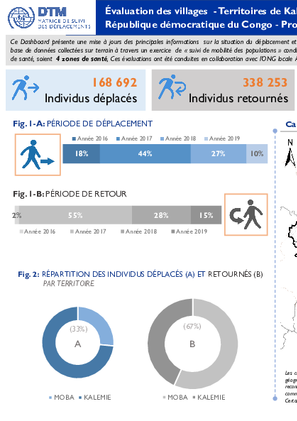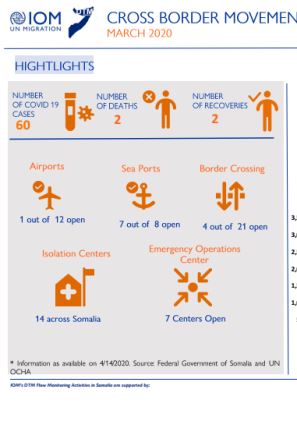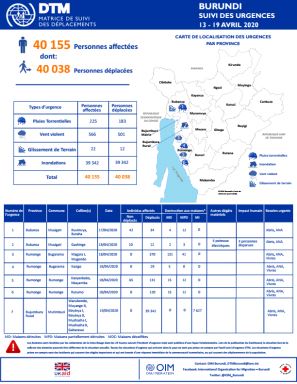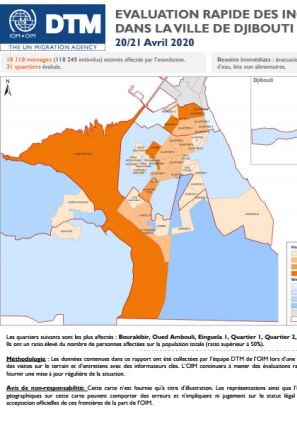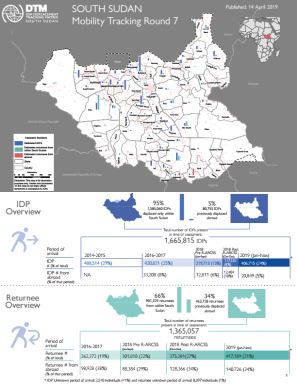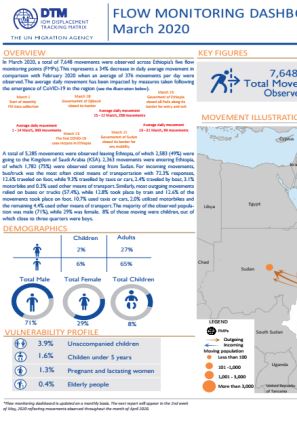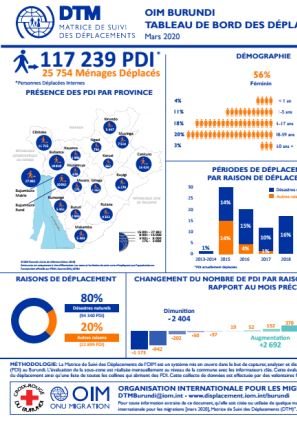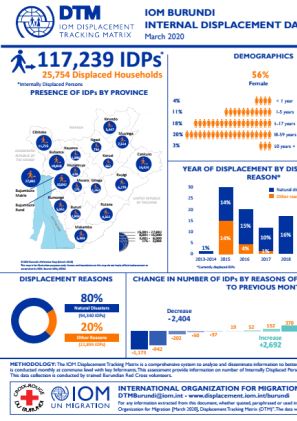-
Countries
-
Data and Analysis
-
Special Focus
-
Crisis Responses
East, Horn and Southern Africa
DTM East, Horn and Southern Africa
DTM Operations in the region
- Active DTM operation
- Past DTM operation
RDC — Tanganyika: Dashboard d'Evaluation des villages -Territoires de Kalemie et Moba (Du 15 Septembre au 12 Octobre 2019)
Ce Dashboard présente une mise à jours des principales informations sur la situation du déplacement et des retours dans les territoires de Moba et Kalemie, en province du Tanganyika.
Apr 24 2020
RDC — Tanganyika: Dashboard d'Evaluation des…
East And Horn of Africa — A Region on the Move – 2019 Mobility Overview in the East and Horn of Africa and the Arab Peninsula
This year’s A Region on the Move report aims to provide an overview of the main population movement trends in the East and Horn of Africa region (EHoA) in 2019.
South Sudan — Biometric Registration Update (March 2020)
IOM's biometric registration has been active since 2014, with 944,709 beneficiaries active in its database to date, out of which 56 per cent (529,421 individuals) are female and 59 per cent (559,185 individuals) are under 18 years old.
Somalia — Border Point Flow Monitoring (March 2020)
In March 2020, a total of 28,859 movements were observed at various Flow Monitoring Points (FMP) across Somalia.
Zimbabwe Flow Monitoring Report (March 2020)
A total of 368,346 regular movements (330,085 at Beitbridge and 38,261 at Forbes) were observed during the month in review, with each Port of Entry (PoE) recording a significant decline in the number of movements observed in February 2020.
Apr 22 2020
Zimbabwe Flow Monitoring Report (March 2020)
DTM South Sudan — COVID-19 Mobility Update 3 (6-12 April 2020)
On 10 April 2020, the Government of South Sudan reported a new COVID-19 case, raising its total number of cases to four.
Burundi — Suivi des urgences (13 - 19 Avril 2020)
Ce tableau de bord présente des informations sur les urgences au Burundi pour la semaine du 13 au 19 avril 2020.
Djibouti — Evaluation rapide des inondations dans la ville de Djibouti (20-21 Avril 2020)
La DTM a identifié 110 245 personnes réparties dans 18 110 ménages, affectées par l'inondation dans la ville de Djibouti.
East and Horn of Africa - DTM Info Sheet 2020
At the regional level, DTM operates under the Regional Data Hub. Established in early 2018, the RDH aims to support evidence-based, strategic and policy-level discussion on migration through a combined set of initiatives.
Apr 21 2020
East and Horn of Africa - DTM Info Sheet 2020
East and Horn of Africa — Monthly Regional Snapshot (March 2020)
The Displacement Tracking Matrix (DTM) in the East and Horn of Africa (EHoA) region is currently active in six countries (Burundi, Djibouti, Ethiopia, Somalia, South Sudan, and Uganda), and its methodology includes four main components (mobility tracking, flow monitoring, registrations, and
Djibouti — Présence Des Migrants Bloqués (19 Avril 2020)
Suite à la fermeture des frontières en Ethiopie et aux renforcements des contrôles frontaliers au Yémen, certains des migrants qui transitaient par Djibouti afin d'aller vers la péninsule arabique se sont retrouvés bloqués à Djibouti.
Djibouti — Évaluation rapide des connaissances, attitudes et perceptions à propos de la maladie à Coronavirus (Avril 2020)
L'OIM a mené une enquête dans la ville d'Obock entre le 29 mars et le 5 avril 2020 afin de mieux comprendre quelles sont les connaissances et perceptions des populations locales et des migrants concernant la maladie à Coronavirus ainsi que l'attitude de ces populations vis-à-vis du virus.
Djibouti — Stranded Migrants (19 April 2020)
Following the border closure in Ethiopia and due to the stricter border management policies in Yemen, some of the migrants who were transiting through Djibouti on their way to the Arabian Peninsula found themselves stranded in the country.
Apr 20 2020
Djibouti — Stranded Migrants (19 April 2020)
East and Horn of Africa (EHA) and Yemen: Regional Impact of COVID-19 on IDPs and Migrants
The current outbreak of coronavirus (COVID-19) has restricted global mobility whilst heightening the risk to vulnerable populations.
South Sudan — Mobility Tracking Report 7 (November 2019)
As of November 2019, the internal displacement profile of South Sudan has shifted from being predominantly marked by national conflict.
Ethiopia — Flow Monitoring Dashboard 7 (March 2020)
In March 2020, a total of 7,648 movements were observed across Ethiopia's five flow monitoring points (FMPs).
Djibouti — Présence des migrants bloqués (16 Avril 2020)
Suite à la fermeture des frontières en Ethiopie et aux renforcements des contrôles frontaliers au Yémen, certains des migrants qui transitaient par Djibouti afin d'aller vers la péninsule arabique se sont retrouvés bloqués à Djibouti.
Djibouti — Stranded Migrants (16 April 2020)
Following the border closure in Ethiopia and due to the stricter border management policies in Yemen, some of the migrants who were transiting through Djibouti on their way to the Arabian Peninsula found themselves stranded in the country.
Apr 16 2020
Djibouti — Stranded Migrants (16 April 2020)
Burundi — Tableau De Bord Des Déplacements Internes (Mars 2020)
La DTM a identifié 117 239 personnes déplacées internes (PDI) et 25 754 ménages déplacés au mois de mars.
Burundi — Internal Displacement Dashboard (March 2020)
The DTM has identified 117,239 internally displaced persons (IDPs) and 25,754 households in the month of February.
DTM South Sudan — COVID-19 Mobility Update 2 (30 March - 5 April)
On 5 April 2020 the Government of South Sudan officially declared the first positive COVID-19 case.
Somalia — Dollow Movement Trend Tracking Report (Annual Report 2019)
79% of the observed movements were entries to Dollow, whereas 21% were exits. An exceptional number of entries was observed in January 2019 with 1,244 people observed entering. The main reasons for travelling were shortage of food (35%), insecurity (27%) and uncomfortable living condition (15%).
Djibouti — 2019 Migration Snapshot
During 2019, 215,710 movements were tracked through 5 FMPs in Djibouti. Almost all of these were Ethiopian nationals travelling through Djibouti en route to the Arab Peninsula.
Apr 06 2020
Djibouti — 2019 Migration Snapshot
Somalia — Baidoa Movement Trend Tracking Report (Annual Report 2019)
89% of the observed movements were entries to Baidoa, mainly from Bakool and Bay regions. Most of the movements were due to insecurity (41%) and shortage of food (25%). A surge in movements was observed in July, 60% was due to a shortage of food.
Pagination
Pagination
- First page
- Previous page
- …
- 21
- 22
- 23
- 24
- 25
- 26
- 27
- 28
- 29
Pagination
- First page
- Previous page
- …
- 17
- 18
- 19
- 20
- 21
- 22
- 23
- 24
- 25
